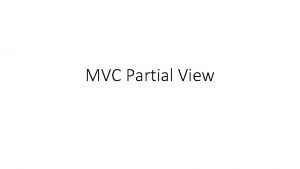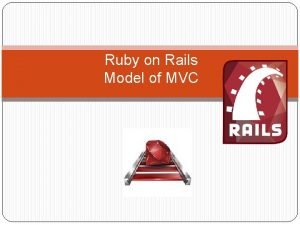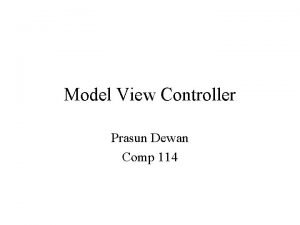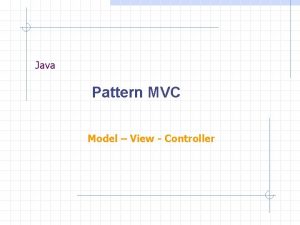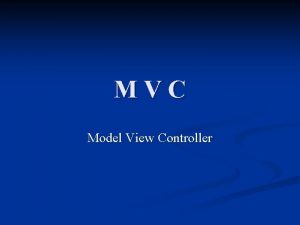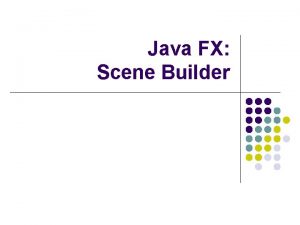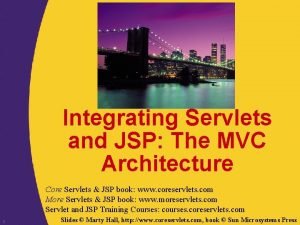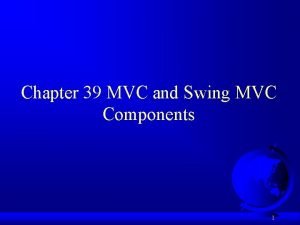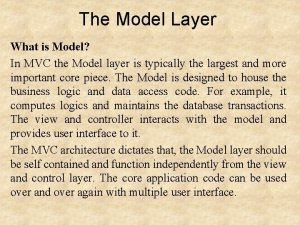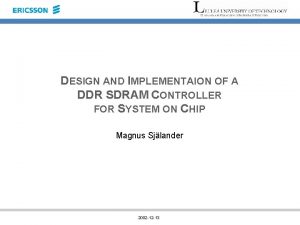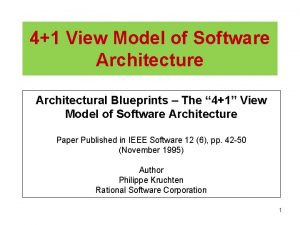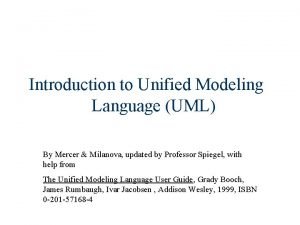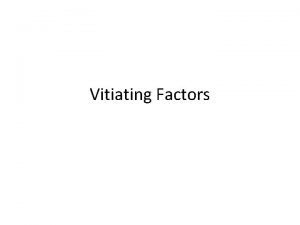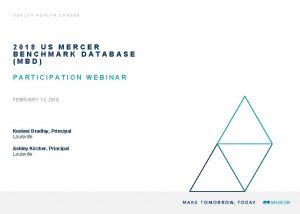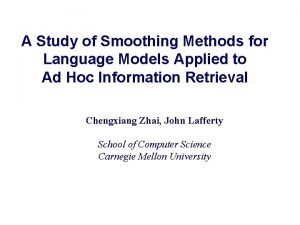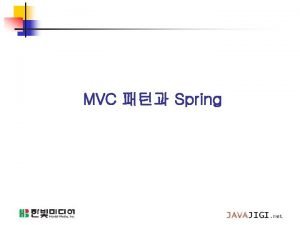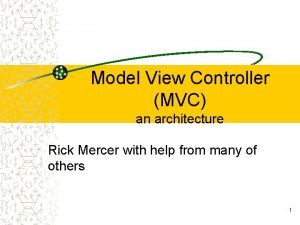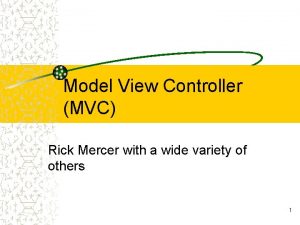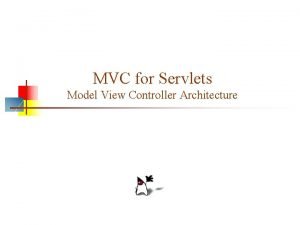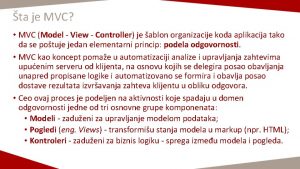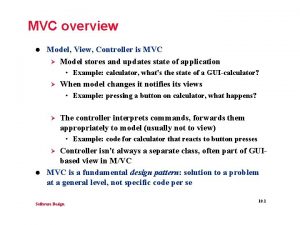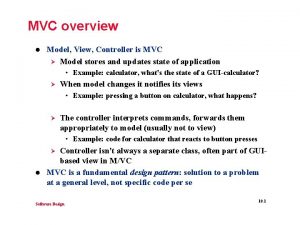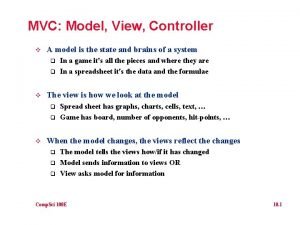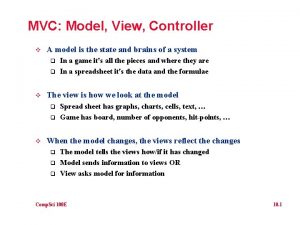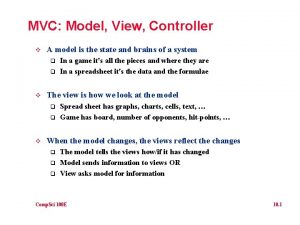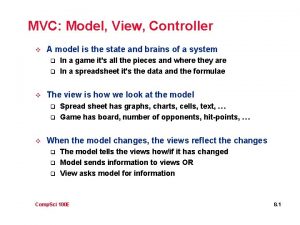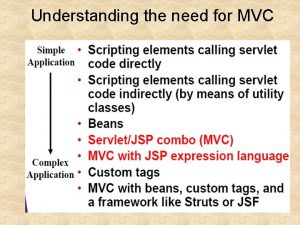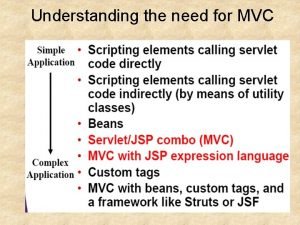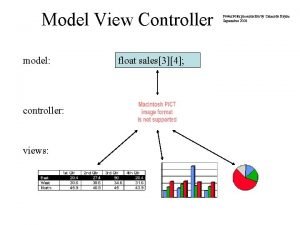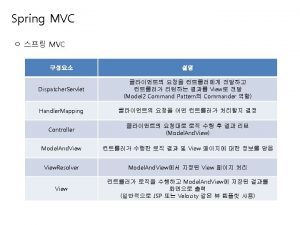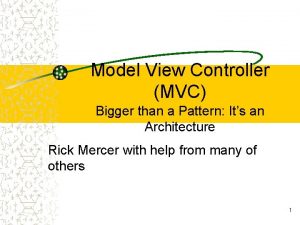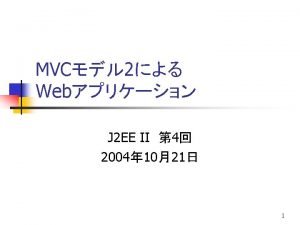Model View Controller MVC an architecture Rick Mercer























- Slides: 23

Model View Controller (MVC) an architecture Rick Mercer with help from many of others 1

Model View Controller (MVC) The intent of MVC is to keep neatly separate objects into one of tree categories – Model • The data, the business logic, rules, strategies, and so on – View • Displays the model and usually has components that allows user to edit change the model – Controller • Allows data to flow between the view and the model • The controller mediates between the view and model

Model The Model's responsibilities – Provide access to the state of the system – Provide access to the system's functionality – Can notify the view(s) that its state has changed

View The view's responsibilities – Display the state of the model to the user At some point, the model (a. k. a. the observable) must registers the views (a. k. a. observers) so the model can notify the observers that its state has changed

Controller The controller's responsibilities – Accept user input • Button clicks, key presses, mouse movements, slider bar changes – Send messages to the model, which may in turn notify it observers – Send appropriate messages to the view In Java, listeners are controllers

MVC Misunderstood MVC is understood by different people in different ways It is often misunderstood, but most software developers will say it is important; powerful Lets start it right: – MVC is a few patterns put together

Smalltalk-80™ In the MVC paradigm, the user input, the modeling of the external world, and the visual feedback to the user are explicitly separated and handled by three types of objects, each specialized for its task. – The view manages the graphical and/or textual output to the portion of the bitmapped display that is allocated to its application. – The controller interprets the mouse and keyboard inputs from the user, commanding the model and/or the view to change as appropriate. – The model manages the behavior and data of the application domain, responds to requests for information about its state (usually from the view), 7 and responds to instructions to change state

Smalltalk-80™ continued The formal separation of these three tasks is an important notion that is particularly suited to MVC Smalltalk-80 where the basic behavior can be embodied in abstract objects: View, Controller, Model, and Object MVC discovered by Trygve Reenskaug in 1979 8

Sun says Model-View-Controller ("MVC") is the recommended architectural design pattern for interactive applications MVC organizes an interactive application into three separate modules: – one for the application model with its data representation and business logic, – the second for views that provide data presentation and user input, and – the third for a controller to dispatch requests and control flow. 9

Sun continued Most Web-tier application frameworks use some variation of the MVC design pattern The MVC (architectual) design pattern provides a host of design benefits 10

Java Server Pages Model 2 Architecture to serve dynamic content – Model: Enterprise Beans with data in the DBMS • Java. Bean: a class that encapsulates objects and can be displayed graphically – Controller: Servlets create beans, decide which JSP to return, do the bulk of the processing – View: The JSPs generated in the presentation layer (the browser) 11

OO-tips writes The MVC paradigm is a way of breaking an application, or even just a piece of an application's interface, into three parts: the model, the view, and the controller. MVC was originally developed to map the traditional input, processing, output roles into the GUI realm: – Input --> Processing --> Output – Controller --> Model --> View 12

Wikipedia writes Model-View-Controller (MVC) is a software architecture that separates an application's data model, user interface, and control logic into three distinct components so that modifications to one component can be made with minimal impact to the others. MVC is often thought of as a software design pattern. However, MVC encompasses more of the architecture of an application than is typical for a design pattern. Hence the term architectural pattern may be useful (Buschmann, et al 1996), or perhaps an 13 aggregate design pattern.

MVC Benefits Clarity of design – easier to implement and maintain Modularity – changes to one doesn't affect other modules – can develop in parallel once you have the interfaces Multiple views – games, spreadsheets, powerpoint, Eclipse, 14 UML reverse engineering, ….

Summary (MVC) The intent of MVC is to keep neatly separate objects into one of tree categories – Model • The data, the business logic, rules, strategies, and so on – View • Displays the model and often has components to allow users to change the state of the model – Imagine pressing arrow on a Hunt. The. Wumpus view Demo Jey. Pressed 15 – Controller

Model The Model's responsibilities – Provide access to the state of the model • getters, to. String, other methods that provide info – Provide access to the system's functionality • change. Room(int), shoot. Arrow(int) – Notify the view(s) that its state has changed // If extending Java’s Obervable class, do NOT forget // to tell yourself your state has changed super. set. Changed(); // Otherwise, the next notify. Observers message will not 16 // send update messages to the registered Observers

View The view's responsibilities – Display the state of the model to users, accept input The model (a. k. a. the Observable) must register the views (a. k. a. Observers) so the model can notify the observers that its state has changed – Java’s Observer/Observable support provides public void add. Observer(Observer o) 17

Controller The controller's responsibilities – Respond to user input (events) • Button click, key press, mouse click, slider bar change – Send messages to the model, which may in turn notify it observers – Send appropriate messages to the view In Java, controllers are implemented as listeners – An Action. Listener object and its 18

Swapping Views Relevant to current project, you will be asked need to swap JPanels (the two Java views) – In our Observer_Simple example, this controller removes and adds Jpanels with this code Two. Observers. Main. this. remove(current. View); // Set current. View to one of the Observers the extends JPanel current. View = … the one selected … // To access the enclosing class use Class. Name. this Two. Observers. Main. this. add(current. View); // I needed both of these refreshes, at least in older Java Two. Observers. Main. this. validate(); 16 -19 Two. Observers. Main. this. repaint();

One view of MVC 20

MVC Misunderstood MVC is understood by different people in different ways It is often misunderstood, but most software developers will say it is important; powerful I believe we started it correctly 21

MVC in an Old Project Tic. Tac. Toe Text. Field. View Drawing. View row _ _ O _ X _ column _ _ _ Action. Listener Mouse. Listener Game 22

Questions Do controllers have a user interface? Does a view allow user input? Can a view send messages to the model? Can a view send messages to the controller? Can you have more than one view? Can a system have more than one 23
 Partial view
Partial view Ruby paradigm
Ruby paradigm Model view controller
Model view controller Model view controller esempio
Model view controller esempio Requerimenti
Requerimenti Java fxml scene builder
Java fxml scene builder Mvc architecture in jsp
Mvc architecture in jsp Swing mvc example
Swing mvc example Model layer in mvc
Model layer in mvc Programmed i/o in computer architecture
Programmed i/o in computer architecture Ddr controller architecture
Ddr controller architecture 4+1 architectural view model
4+1 architectural view model Bradshaw mercer social needs
Bradshaw mercer social needs Introduction to unified modeling language
Introduction to unified modeling language Tim mercer golf
Tim mercer golf Vitiating factors
Vitiating factors Mercer job matching booklet 2020
Mercer job matching booklet 2020 Mercer canvs
Mercer canvs Ramona t. mercer
Ramona t. mercer Jelinek mercer smoothing
Jelinek mercer smoothing Mercer medical library
Mercer medical library Mercer human capital
Mercer human capital Mercer ipe framework
Mercer ipe framework Non est factum
Non est factum
